16 million newcomers gain Internet access in the last half of 2000 as women, minorities, and families with modest incomes continue to surge online
The changing online population: It’s more and more like the general population
During the second half of 2000, when much attention was focused on the struggles of dot-com firms, the overall Internet population continued to grow at a healthy clip as women, minorities, those earning between $30,000 and $50,000 flocked online, and parents with children at home flocked online. In fact, there were substantial gains across the demographic board as millions of newcomers joined the online world and millions of others expanded the activities they perform online.
Comparing figures gathered in our tracking survey in May and June with figures gathered between Thanksgiving and Christmas, we find that the number of American adults with Internet access grew from about 88 million to more than 104 million in the second half of 2000. Furthermore, we began asking new questions in November and December that allow us to calculate how many children have Internet access. The responses to those questions show that 45% of America’s children – or more than 30 million of those under age 18 – have Internet access. Fully 73% of those between ages 12 and 17 have Internet access and 29% of those under 12 have been online.
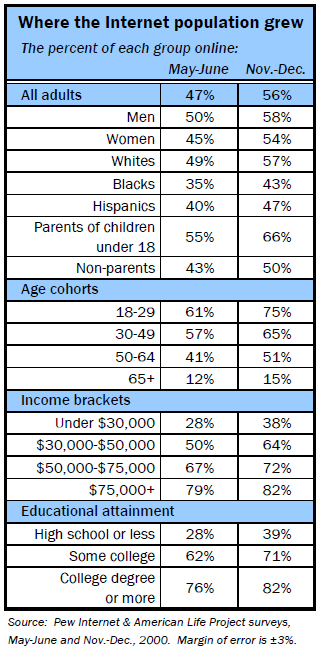
The increase in online access by all kinds of Americans highlight the fact that the Internet population looks more and more like the overall population of the United States. However, there are still some notable demographic differences when it comes to access. The most dramatic disparities are defined by income and age. The income gap looks this way: 82% of those living in households with more than $75,000 in income now have Internet access, compared to 38% of those in households earning less than $30,000. The good news is that those at the low end of the economic scale are coming online relatively rapidly. Only 28% of those in lower-income households were online in May-June.
The gray gap looks this way: 75% of those between ages 18 and 29 have Internet access, compared to 15% of those 65 and over. The increase among senior citizens was also healthy – it is up from 12% in May-June – but there continues to be substantial reluctance among many seniors to getting Internet access. (For more analysis of the reasons why, see our report, “Who’s Not Online: 57% of those without Internet access say they do not plan to log on.”) At the same time, there was enormous growth in Internet access by those between ages 50 and 64.
Meanwhile, the Internet is becoming ever more attractive to women and minorities. Women have pulled slightly ahead of men in the overall Internet population; 50.6% of American adults with Internet access are women and 49.4% are men. In addition, online women are almost as likely now to be using the Internet on a typical day as men are. A disparity still exists between men and women online as percentages of their own populations because there are more women in America than men. Thus, as the table on the previous page shows, 58% of American men have Internet access now and 54% of women have access.
The African-American population online grew eight percentage points and that yielded a growth rate of more than 22% during the final half of 2000. A substantial share of the increase came from African-American women. Some 45% of black women had Internet access at year’s end, compared to just 34% at mid-year. The increase in Internet access among black men was notable, but less substantial. During the same period, the Hispanic population grew seven percentage points and that means the growth rate was more than 17% in late 2000. This growth was fairly evenly divided among men and women.
In some population segments, Internet penetration is getting quite high: 75% of those age 18-29 now have access; 82% of those with college or graduate degrees have access; 82% of those living in households with incomes over $75,000 have access; and almost two-thirds of parents with children living at home have access. However, it is also noteworthy that the growth rates among those with high incomes and college educations were modest. This suggests that saturation penetration of the Internet even among those at the highest socio-economic levels could still be several years away. (By comparison, 94% of U.S. households have telephones and 98% have televisions and the penetration of both technologies in the highest socio-economic brackets approaches 100%.)
Time spent online
Some recent studies have shown a drop in Internet use in the final part of 2000 and that has prompted some to wonder if people were losing interest in the Internet or if some kind of Internet “fatigue” had set in. PricewaterhouseCoopers, the business consulting firm, reported in November that the average American user spent 4.2 hours a week on the internet, 1 hour less than in 1999. And a few weeks ago, Nielsen/NetRatings, an Internet audience-measuring company, reported that the average time a person spent online totaled 14.9 hours during the month of December, a drop from 16.5 hours in November and 17.5 hours in October.
Our data suggest the time the average person spent online on the average day dropped by a few minutes between May-June and November-December. There was a slight decrease at the end of the year in the number of people who use the Internet for two or more hours and a slight increase in the number who use the Internet for between an hour and two hours a day. This fractional decline could be explained by several factors. Some measuring services have noted a regular seasonal drop in Internet use in the Thanksgiving-Christmas-Chanukah period in previous years and this might have happened in 2000. The drop also might be explained by the changing nature of the Internet population. Newcomers use the Internet less often and for shorter periods than veterans do and the arrival of so many newcomers to the Internet population in the past year might help explain why the time spent online by the “average” user is dropping.
At the same time, our surveys also show that the total number of American adults using the Internet on a typical day increased in the second half of 2000. In May-June, 52% of Internet users were online during a typical day; in the last months of 2000, 56% of Internet users were online during a typical day. That represents an increase from 47 million American adults using the Internet per day at mid-year to over 58 million per day at the end of the year.
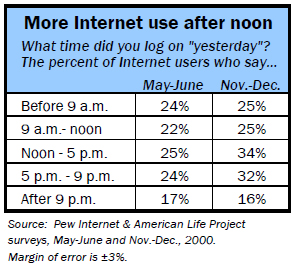
In addition, we found some evidence that people are using the Internet more frequently at different times of the day. The late-year survey showed there were striking increases in Internet usage during the afternoon and early evening on a typical day online. This might result from seasonal factors. As weather got more rugged, it is likely more people were indoors during the afternoon and early evening.
More online activities on a typical day
The increase in the overall online population is just part of the story about how online life is being embraced enthusiastically by Americans. Comparing mid-year to end-of-year traffic, more Americans were going online on a typical day to read and send email, and checking out several features of the Web at the end of the year. It is also important to note that the overall increase in the daily Internet population contains substantial increases among some types of online Americans – an indicator that the network is becoming more valuable to users as more and more people go online. In the most basic terms: A higher percentage of a bigger population were going online each day at the end of 2000 than were accessing the Internet on a typical day in May-June.
One striking jump in this daily population occurred among women, whose daily presence online was boosted 6 points – 55% of women with Internet access went online during a typical day in December, compared to 49% of women with Internet access who went online on a typical day in May-June. Women are now very close to parity with men on a typical day online, whereas in May-June men outnumbered women online by a margin of 54% to 46%.
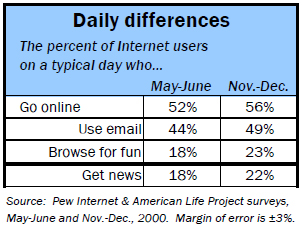
For African-Americans, the sharp increase in the daily population is particularly significant. In the last weeks of 2000, 44% of blacks with Internet access were online on a typical day; that is up from 37% in May-June. We noted in earlier reports that one element of the digital differences between whites and blacks related to daily use of the Internet: At mid-year we found that whites were much more likely than blacks to be online on a typical day. The November-December survey shows that African-Americans are increasingly likely to find uses for the Internet on a typical day and the gap between blacks and whites in the daily Internet population is shrinking.
Some other increases in the daily Internet population worth noting came among the middle aged (those between 30 and 49), those with some college education or a college degree, those in households earning less than $30,000 or over $50,000, and those who are parents of children under 18.
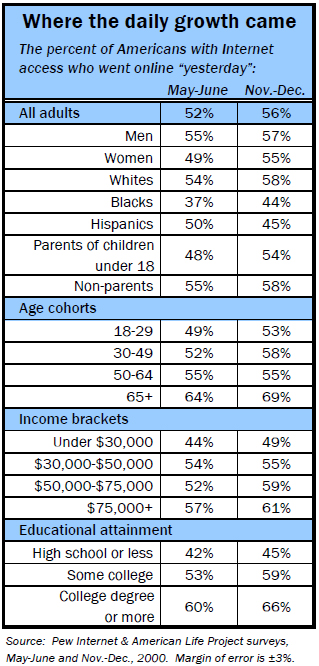
In many cases, these are the same groups that have increased their use of specific features of the Internet, such as email, getting hobby information, and browsing for fun. For instance, the total number Americans using email on a typical day increased from 44% of the Internet population to 49%. One of the large increases came among females. At the end of the year, 49% of women with online access were sending and receiving email on a typical day. That was a jump of 7 points from mid-year when 42% of women with Internet access were using email on a typical day. In fact, women have now surpassed men in their use of email on a typical day – 48% of men with Internet access use email on that typical day.
There was also a sharp increase in the number of blacks using email on an average day. Some 36% of blacks with Internet access were sending and receiving email on a typical day at the end of 2000, compared to 26% of blacks with Internet access sending email during a typical day at mid-year. This clearly is a factor in the increase in the overall black population on a typical day and a sign that more online blacks are finding that the Internet is a helpful tool in everyday living.
The election and the disputed result
One major source of traffic to the Internet in the final weeks of 2000 was the presidential election and the dispute over the results. We have reported elsewhere that the number of Americans who got campaign news grew fourfold between 1996 and 2000 (see “Internet Election News Audience Seeks Convenience, Familiar Names: Youth Vote Influenced By Online Information”). Our November-December survey shows that 48% of Internet users, or about 50 million Americans, got news about the campaign from the Web. Only a third of Internet users (34%) told us in May-June that they had gotten political news and information from an online source.
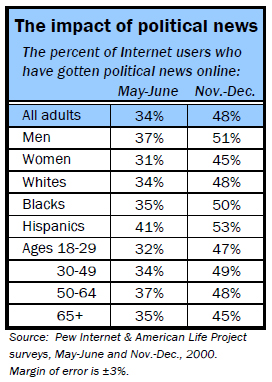
On a typical day in late 2000, 17% of Internet users were getting political news, a doubling of the number who were getting it on a typical day in October and a tripling of the number getting political news at mid-year. Online men were more likely than women to be getting such news on that typical November-December day; well-to-do Internet users were more likely to be getting political news than less-well-off Americans; and online Republicans were more likely to be checking the daily story than Democrats or Independents.
Expanding online activities
Another major story of online growth involves particular Internet activities. Millions more Americans have sampled online fare in various Web categories. This makes sense, because the passage of time gives all types of Internet users a chance to try new activities.
We asked respondents in both surveys about 10 Internet activities and there were increases in each, though some of them are within the margin of error. It is still important to remember that in each case, we found that a higher percentage of a bigger population is turning to the Internet to pursue these activities. Here are some of the most significant aspects of our findings related to particular activities:
- Hobby information: Besides email, the hunt for hobby information is the most popular feature on the Internet. This activity saw an 8-point jump during the second half of 2000 as 79% of Internet users say they have sought such material. This six-month increase in traffic means that 20 million more online Americans had used Web tools to pursue their hobbies than had done so at mid-year. The search for hobby information is slightly more popular with online men than online women and it is especially compelling to younger Internet users, 82% of whom have sought hobby information. Between mid-year and end-of-year, the percentage of online blacks who had sought hobby information had grown from 65% to 77%; the percentage of online Hispanics getting such information jumped 16 points to 75%. In addition, individuals in the 50-64 age bracket increased their use of the Internet for hobby material by 13 points to 76%.
- Browse for fun: This is an Internet activity that is relatively engaging to newcomers, who do it at almost the same rate as veterans. So it is not surprising that during a period of solid growth in the Internet population, the number of people using the Internet to wile away the hours would increase. Some 68% of Internet users reported to us in November-December that they had surfed the Web for fun; that is a 7-point increase from May-June and represents a 15-million person increase of the number of online Americans who have browsed for fun. Older Americans and those with less than high-school educations showed some of the biggest gains.
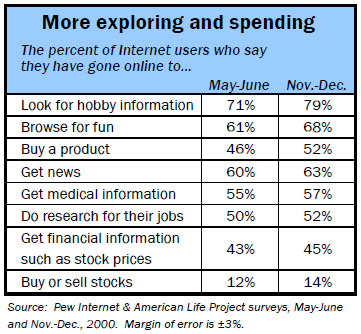
- Buy a product: More than half of those who have Internet access (52%) have bought a product online at one time or another. This is a 6-point increase from May-June, which means that about 14 million more Internet consumers were created in the last half of 2000. Generally, Internet purchasers are more likely to be veteran users and they are more likely to have come from higher socioeconomic levels. Those who live in households earning more than $75,000 are more likely than those from less well-off households to have bought goods online and those with college degrees are more likely to have bought products online than those who don’t have degrees. Online women are slightly less likely than online men to have ever bought a product online. But on a typical day at the end of 2000, more online women were making purchases than men. This might be a result of the holiday shopping season, though it is also the case that men were generally more enthusiastic about online shopping than women were. African-Americans with Internet access, who used to lag significantly behind whites in their willingness to purchase goods online, have dramatically narrowed the divide. Fully 48% of African-Americans with Internet access said that as of November-December they had bought products online; that’s an increase of 12 points from May-June. The increase among online whites during the same period was from 47% in May-June to 52% in November-December.
- Health information: This is still more popular among online women than men and it is one of the most serious activities that Internet newcomers pursue. In all, about 60 million Americans have used the Internet to seek health and medical information. The largest increases between mid-year and the end-of-the-year came in several groups: 58% of African-Americans with Internet access had sought health information, according to the November-December survey, which is a jump of 6 points from mid-year. The seeking of health information also became more popular among those in the 50-64 age bracket. Fully 63% of those that age with Internet accessed used the Web for health information – an increase of 9 points from mid-year.
- Work-related research: Internet veterans (those with more than three years experience) are very comfortable doing work-related research online. Well-to-do Internet users showed sharp growth in this activity. Fully 63% of them have done work-related research online, up 9 points from mid-year. Another large jump occurred among those with less than a high school education, up 8 points to 37%, suggesting that more and more types of jobs, including low-skilled posts, are tied in some way to the Internet.
- Online news: The overall increase in those getting general news online (as distinct from political and campaign news) was modest at the end of 2000. This is a feature of the Internet that online men like more than online women and that upscale Americans are more inclined to use than those with lesser incomes. There was a substantial increase in use of the Internet for news among certain online Americans. Fully 71% of online blacks have used the Internet to get news, a jump of 7 points from the May-June survey. That high incidence of online blacks getting news in the November-December survey compares to 61% of online whites who have ever used the Internet to get news and 62% of online Hispanics. Another large increase took place among those living in households earning between $50,000 and $75,000. Fully 68% of those in that income category have sought news online, up 8 points from the May-June survey.
- Financial information: The basic story remains unchanged: Well-off Americans are more likely than others to use the Internet to check the prices of stocks, bonds, mutual fund shares, and mortgage rates. Men are more likely than women to seek such information. Online Hispanics showed a sharp increase in getting information about stocks, bonds, mutual funds or mortgages. In the May-June survey, 33% of Hispanics with Internet access had gotten such information; in November-December, the number had jumped 16 points to 49%. This compares to 45% of online whites who have sought financial information on the Web and 40% of online African-Americans.


